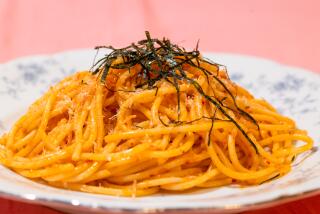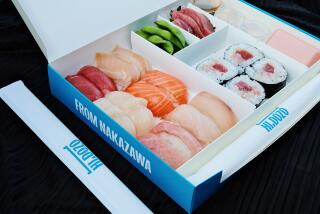Sipping Sake in Japan Is to Drink In Tradition
TOKYO — Anyone who has been to Japan in the middle of winter knows how appropriate it is that warm sake is their national drink. The first time I arrived in Tokyo was during a December blizzard.
Ducking into a pint-sized neighborhood bar, I shook off the snow, squeezed onto a seat at the counter and ordered sake. Within minutes the clear, warm liquid had magically warmed me. Suddenly, the Japanese gentleman beside me reached over for my small bottle and refilled my cup. “It’s tradition that you never fill your own cup,” he explained, introducing himself.
During the next couple of lively hours, conversing via my Berlitz phrasebook and imbibing countless rounds of sake that I justified as cultural research, Osamu Nichi enlightened me about the intricate details of sake drinking, born--like everything else in Japan--from thousands of years of finely honed tradition.
Now when I dine at a sushi bar I can casually mention how amusing it is that most people think a sakazuki is a Japanese motorcycle. Odds are no one else will know it’s the thimble-size cup from which to sip a potion still so important that few Japanese feel married without the ceremonial nine sips of sake--three for the bride and six for the groom. It is the proper accompaniment for an evening in the company of geisha. And though it’s often called rice wine, it is actually brewed in a process akin to beer making.
Sake (pronounced sah-kay) has a clean, nut-like flavor and is part of everyday life in the “land of the rising yen.” There are few places where you can’t get it. I’ve tucked into a tokkuri or two zipping along at 170 miles an hour on the bullet train, had it served to me by a kimono clad mama-san in the steamy enclave of a public bath, and have crept out at night from my ryokan inn with a handful of coins to buy pre-warmed, one-shot Ozeki bottles from a suburban sidewalk vending machine.
The classic style of serving is to decant from the bottle (a whopping 1.8-liter bottle is standard in Japan) into individual porcelain flasks called tokkuri that are then placed in a saucepan of warm water until the sake reaches 104 degrees. But sake need not be served warm. In Japan it long has been enjoyed cold. In fact, some sakes are brewed especially to be drunk straight out of the refrigerator. On the rocks it makes a refreshing summer drink. Mix sake with orange juice for an Oriental screwdriver, or with three parts dry gin and an olive for a sake martini.
Good manners dictate that you pour for your companions who, in turn, fill your sakazuki. Raise the cup (this is for purists only) with the thumb and first two fingers of the right hand, placing the first two fingers of the left hand under the bottom. Your sakazuki should not be filled to the brim, and when you’ve had enough, place your hand over your cup when offered more or turn it upside down on the table.
Catering to true sake aficionados are a handful of gourmet sake bars that stock 300 or more rare and special brews, most of them created by small family brewers. Each is stored at precisely the correct temperature specified by the marker and served in exactly the right shaped tokkuri and sakazuki. Several are in the Ikebukuro area, a short subway ride from downtown Tokyo where many out-of-town Japanese stay when they visit the city. Though they don’t necessarily have traditional Japanese decor, they are mecca for sake lovers.
During my last trip, I visited Akaoni in Tokyo, a special sake bar that features live jazz, where we ordered a selection of four unusual sake to sample and compare. These are not drinking party establishments to spend the evening becoming bleary eyed; the bill for four small tokkuri came to more than $100.
Sake dates back thousands of years, to the earliest days of rice cultivation in Asia, but the original brew was likely a rough-tasting alcoholic rice soup--nothing like the clear, refined sake of today.
Revered as a divine beverage and offered to the gods on auspicious occasions, it was made in earliest times by a curious method known as diastases. Young women chewed steamed or soaked rice along with water, the amylases in the saliva converting the rice starches into sugars that, added to the main mash, allowed fermentation to follow. In some districts this ancient method is still ritually practiced at shrines and festivals, and even today the noble brew carries the honorific prefix o as in o sake in deference to its importance in both religious and social ceremonies.
A growing popularity of whiskey and beer among young Japanese, plus competition from large modern breweries have taken their toll. Family sake makers, who remain faithful to old brewing methods, have dwindled from 27,000 at the end of the 17th Century to fewer than 3,000 today. Although big breweries use refrigerated equipment and produce year-round, dead of winter is traditional sake-making time because the fresh rice used is harvested in autumn and fermentation must take place below 59 degrees.
I visited a small family operation called Ginsetsu on the outskirts of Tokyo. Amid great open enameled vats steaming in the cold air where sake is fermented for 25 days, the sake maker explained that he still buys his rice--a variety grown especially for sake production--from the same farmer as his great grandfather.
Sake varies from maker to maker. The exact proportions of ingredients and how and when they are added are a sake maker’s most closely guarded secret. The large grained rice is highly polished, steeped in the purest of water, steamed and allowed to cool. A portion is taken to a humid incubation room known as a koji muro and inoculated with a special sake mold. After 36 hours, the moldy rice is mixed with steamed rice, water and sake yeast to produce the main fermentation mash.
Unlike beer brewing, the main mash in sake is dense and mushy, with solids retaining large quantities of yeast cells during fermentation, one of the reasons sake has an alcohol content of up to 20%, the highest for fermented drinks. The raw sake is pumped out, filtered and allowed to clarify by settling for 10 days before being pasteurized.
New sake is bottled in a variety of containers--from the latest pull-tab cans to the huge straw-covered barrels that are a common sight stacked outside restaurants, bars and temples.
Traveling around Japan, I like to browse through the selection of hundreds of regional brands of sake in elaborate pottery or decorated porcelain bottles that are popular souvenirs among the Japanese. Occasionally, at increasingly rare sidewalk sake stalls, I still come across the hand-sized wood boxes from which Japanese workers drink their sake with a dash of salt on the rim. Some restaurants use special white cups featuring two blue rings on the inside bottom, actually brewers’ testing cups for judging sake’s pale golden hue.
Graded into special, first and second classes, sake is usually drunk within a year to avoid overaging; kept in the refrigerator it doesn’t “go off” once opened.
The biggest selling brand in Japan is Gekkeikan, sake makers since 1637 and purveyors to the Imperial Household for more than two centuries. Gekkeikan is available in 720 milliliter bottles at most liquor stores; premium Gekkeikan Gold Sake at specialty outlets.
A word to the wise: Warm sake is rapidly absorbed into the bloodstream, and with all those tiny cups continually refilled by someone else, it’s easy to lose track of exactly how much you’ve sipped. Keep count and avoid too many “Kampai!” , or bottoms up. Overindulgence can deliver one of the world’s truly awesome hangovers.
GUIDEBOOK: Sampling Sake in Japan
Special sake sampling establishments:
(Few Japanese, even in Tokyo, speak more than a few words of English. The staffs in these establishments are eager to help foreign guests, but to get more out of your sake-drinking experience, it would be wise to take along a Japanese friend. Most places are closed Sundays.)
Tokyo: Akebono 2-4-6, Ikebukuro, Toshima-ku, Tokyo; call 03-3988-3545. Dengyobo 2-41-9, Minami-Ikebukuro, Toshima-ku, Tokyo; call 03-3981-2500. Sasashu 2-2, Ikebukuro, Toshima-ku, Tokyo; call 03-3971-6796. Sawamura 1-11-1, Dogenzaka, Shibuya-ku, Tokyo; call 03-3464-8870. Akaoni 2-15-3, Sangenzaya, Setagaya-ku, Tokyo; call 03-3410-9918 (features live jazz music).
Kyoto: Issei Higashi-iru, Higashi-no-toin, Nishikikoji-dori, Kyoto; call 075-211-0824.
More to Read
Eat your way across L.A.
Get our weekly Tasting Notes newsletter for reviews, news and more.
You may occasionally receive promotional content from the Los Angeles Times.









